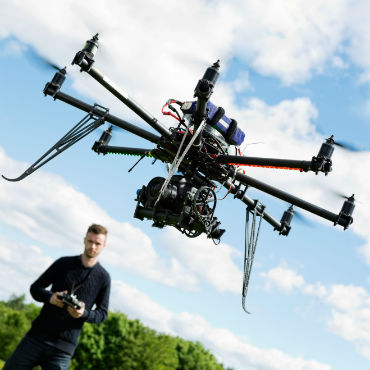Trump tells FAA to move faster on drone traffic control

The administration has issued new mandates for accelerating the integration of unmanned aerial systems into the national airspace.

The Trump administration is taking new steps to speed the integration of unmanned aerial systems into the national airspace.
An Oct. 23 memo from the president calls for an UAS Integration Pilot Program to be stood up within the next 90 days. Under the program, the Federal Aviation Administration will work with state, local and tribal governments to establish UAS testing zones and build a regulatory framework for unmanned systems operation.
Specifically, the memo calls for the FAA to:
- Accelerate testing of currently restricted UAS operations, such as beyond-visual-line-of-sight flights and flights over people.
- Open the skies for the delivery of medicines and commercial packages, inspections of critical infrastructure, emergency management operations and crop surveys for precision agriculture applications.
- Test new UAS traffic management systems and detection and tracking capabilities.
- Increase the number and complexity of UAS operations across the nation.
The UAS Integration Pilot Program will "provide a mechanism for state, local and tribal officials to contribute their views to the UAS policy framework, without infringing on the U.S. government’s jurisdiction over the national airspace,” said Brian Wynne, president and CEO of the Association for Unmanned Vehicle Systems International, a nonprofit that supports drone users and manufacturers. “Maintaining federal authority of the airspace will help foster innovation and allow states, municipalities and tribes to tap into the full potential of UAS, while continuing to keep our skies safe.”
“Stakeholders will have the opportunity through this program to demonstrate how their innovative technological and operational solutions can address complex unmanned aircraft integration challenges,” said FAA Administrator Michael Huerta. “At the same time, the program recognizes the importance of community participation in meaningful discussions about balancing local and national interests related to integrating unmanned aircraft.”
The push to get more drones in the air, however, has caused problems for people on the ground.
The FAA has been overwhelmed by requests from drone users who want to fly in controlled airspace around airports, creating a backlog of thousands of requests and distracting air traffic control operators from their primary responsibilities, according to an emergency request filed by the FAA to automate this approval process.
That request has been approved, and the agency received permission from the Office of Management and Budget on Oct. 19 to begin an evaluation of the industry-developed Low Altitude Authorization and Notification Capability tool. LAANC processes airspace notifications in near-real time and gives drone operators automatic approval of requests for flights that are below approved altitudes or in controlled airspace. The evaluation began four days later, an agency spokesperson told GCN.
Under current regulations, any drone operator who wants to fly in controlled airspace must fill out a request on FAA’s official portal, which the agency promises to have processed within 90 days. This system hasn’t worked well for businesses who promise drone imaging to clients, according to Scott Pitta, the president and CEO of the Association of Professional Drone Pilots.
“A lot of these approvals took a lot longer than 90 days, some took 120 days,” Pitta said. “In this industry that is just unworkable.”
There are other requirements around flying in certain weather conditions and below cloud cover that make it impossible for operators to plan flights far in advance, he said.
“The result has been that a lot of operators have had to make the choice of either do I lose the revenue and just walk away from the potential client, or do I risk it and fly in violation of the regulations,” he said. “And more and more operators have chosen to risk it and go and make the flight because they need the revenue.”
With LAANC, drone pilots will be able to get authorization within 5 minutes, according to the FAA. So far two private companies have been approved to test this service: Airmap and Skyward. Pitta said he hopes the FAA also will include the functionality on its website so users aren’t forced to use third-party apps to operate in public airspace.
The technology is welcomed by industry and that it will help meet growing demand, Wynne said.
“Automating the FAA’s IT system, including the authorization process to fly near airports and other controlled airspace, is vital to safely manage UAS operations.”
A version of this article first appeared on GCN.com.


